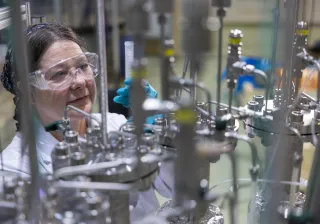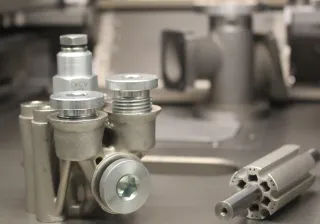VTT's prototype attracted considerable attention at the international Formnext and World PM fairs. The unique method based on additive manufacturing, or 3D printing, challenges the traditional way of building electric motors.
The annual Formnext and World PM fairs bring together international professionals of additive manufacturing. At both fairs, VTT Technical Research Centre of Finland introduced a prototype of an electric motor, some of whose components were produced by 3D printing. Similar prototypes have not previously been seen in fair use, which is why the fair participants were very interested in the motor.
The ferromagnetic cores of the prototype, that is the magnetic field conducting parts of the stator and rotor, are made by 3D printing. In addition, a cover made of cellulose-based material was 3D printed for the model motor cables. At the fairs, a smart shaft was attached as the load for the electric motor, but any other load can be attached, too. Like the prototype motor, the cellulose-based cover for the cables and the smart shaft are all developed at VTT.

3D printing facilitates development and testing of new types of components
The new manufacturing method has several advantages. One of them is that the printing process does not generate much waste. In addition, testing new innovations is easy compared to other manufacturing methods, as the printing of prototypes is fast and relatively inexpensive. A faster development process increases the breakthrough of new technologies and innovations because new ideas can be produced more flexibly, and different experiments can be carried out.
At its best, 3D printing can significantly simplify the manufacturing process of electric motors. Traditionally, ferromagnetic components are made from electrical steel sheets that are stamped or laser-cut in the desired form. The steel sheets are then stacked into ferromagnetic cores, welded together and possibly heat treated. With 3D printing, the operations can be reduced.
3D printing can also be used to manufacture motors or generators that have previously been technically difficult to manufacture. They have, therefore, not been commercially profitable. The manufacturing method is particularly interesting for, for example, the military and the aeronautical and aerospace industries, where maximum performance and reliability are important. As the manufacturing technologies develop, the automotive industry, large electrical machine manufacturers and workshops can also benefit from 3D printing.
The methods developed by VTT can be used to manufacture all applications using ferromagnetic components, from electric motors to inductors and transformers.
Additive manufacturing renews traditional field of research
Electrical machines are an old, traditional field of research that 3D printing as a manufacturing method renews. At VTT, the research focuses especially on whether 3D printing could promote the manufacture and spread of electrical machines that are, on paper, very good but difficult to implement. The research covers the entire manufacturing chain from the design of the electrical machine and the manufacture of materials to the 3D printing of parts, and further to the assembly and testing.
VTT's ten-person team has been studying the 3D printing of ferromagnetic parts and their utilisation in electrical machines since 2014. The purpose of the research is to understand the methods required for the manufacturing process of motors using 3D printing. The prototype produced now produces masses of information on the requirements, benefits and potential challenges of 3D printing. The aim is to develop more low-loss 3D printed components for better performing electric motors.










